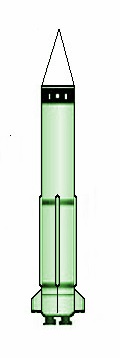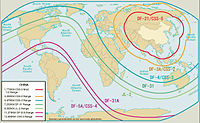CSS-2
| CSS-2 | |
|---|---|
| General Information | |
| Type | Medium-range missile |
| Manufacturer | Plant 211 ( Hauptstätdtische Raumflugkörper GmbH ) |
| development | 1960s |
| Commissioning | 1987 |
| Technical specifications | |
| length | 21.20 m |
| diameter | 2,250 mm |
| Combat weight | 64,000 kg |
| Drive First stage Second stage Third stage |
Liquid rocket engine. Liquid rocket engine. Liquid rocket engine |
| Range | 2,650 km |
| Furnishing | |
| Target location | INS |
| Warhead | 1 nuclear warhead 1,000 or 3,000 kt or fragmentation warhead of 2,000 kg |
| Weapon platforms | Mobile on a semi-trailer |
| Lists on the subject | |
The CSS-2 is a land-based medium -range ballistic missile of the People's Republic of China . In the Chinese armed forces, the rocket is called " DF-3 " or " Dongfeng 3 ".
development
Development of the CSS-2 began in the mid-1960s. The CSS-2 was the People's Republic of China's first ballistic missile to be built without the support of the Soviet Union . Test starts and flight attempts were carried out between 1966 and 1968. In 1970 the first rockets were handed over to the People's Liberation Army .
The improved version "CSS-2A" was introduced in 1987. This version has a modified steering system and achieves a hit accuracy ( CEP ) of around 1,000 m. The range has also been increased to 2,800 km.
The People's Liberation Army procured 90 to 100 systems. In the 1980s, 30-40 systems were upgraded to the CSS-2A level. In 1987, Saudi Arabia procured around 60 CSS-2As and 15 associated transport and launch vehicles , bypassing the missile technology control regime.
technology
The entire system is transportable and transportable on roads. The rockets and all components are housed on trailer trains. It takes 120–150 minutes to prepare for the start and to prepare for fire readiness. Both versions are single-stage liquid propellant missiles. The CSS-2 uses the storable liquid fuels 1,1-dimethylhydrazine and dinitrogen tetroxide as fuel . The CSS-2 is controlled using an inertial navigation platform . A precision ( CEP ) of 1,000–2,000 m (depending on the version) is achieved. As a result of the relatively poor accuracy of hits, the CSS-2 can only be used against so-called "soft targets" such as population centers, industrial complexes, port facilities and railway junctions. US and NATO experts rate the CSS-2 as an ineffective second-strike weapon .
status
The CSS-2 is now considered technically obsolete. In the People's Liberation Army, the 15-20 CSS-2 systems are currently being eliminated and replaced by the DF-21 and DF-25 . No details are known about the status of the Saudi Arabian systems.
swell
- JANE'S STRATEGIC WEAPON SYSTEMS Edition 2003 . Jane's Publishing House.

